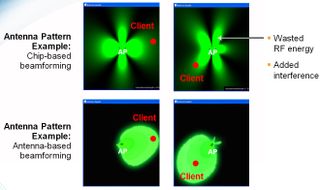Beamforming: The Best WiFi You’ve Never Seen
On-Chip Challenges
Now that you get the gist of how beamforming works, you’re probably wondering why the technology never went mainstream. After all, in comparison, trying to optimize signal strength with several antenna jutting from a conventional 802.11n access point is a joke. These multiple antennas are, in a way, glorified rabbit ears. Even if you spend the time to fiddle with them and get what seems to be the best throughput in a given spot with the antennas set in just such a way, what happens if you have to move the access point or the end client? What if you add a second or third client? It’s chaos. The fact is that proper signal optimization with current-gen products is futile.
Why hasn’t intelligent beamforming, which has the ability to sense optimal phasing and orient beams for multiple clients, been widely adopted? It’s a mystery—probably another one of those “we as an industry are still in the process of discussing various blah blah blah” things.

A skeptic might suggest that on-chip beamforming hasn’t taken off because it’s sounds better on paper than it is in real life. We know that, in theory, beamforming should save power. You only need to boost the signal in a certain direction and drop power for any signals that don’t assist that beam. The problem here is that when you’re dealing with omnidirectional antennas, there’s only so much control you can have over your beams.
For an intriguing illustration, check out Falstad’s Antenna Applet and be sure to choose Broadside Array from the top pull-down menu. You can increase antenna counts, play with the distances between them, and modify signal strengths. As you’ll see, with two omnidirectional antennas you never get away from having a lot of beams, and therefore energy expended in unneeded directions (these unwanted beams are often called backlobes). Naturally, if you have beams going off in stray directions, these can cause co-channel interference and impede the signal you actually do want.

It seems likely that next-gen 802.11n will incorporate implicit and explicit beamforming at some point, as there are very few technical or cost barriers. However, which approach will vendors integrate? And we haven’t even scratched the surface on options. For example, there are three sub-types of explicit beamforming. So if there’s one culprit behind the lack of beamforming adoption, concerns over interoperability is probably to blame. For those of who find yourselves thinking, “Come on! I don’t care about 100% interoperability. I just want crazy good wireless performance in my space,” keep reading.
Stay on the Cutting Edge
Join the experts who read Tom's Hardware for the inside track on enthusiast PC tech news — and have for over 25 years. We'll send breaking news and in-depth reviews of CPUs, GPUs, AI, maker hardware and more straight to your inbox.
Current page: On-Chip Challenges
Prev Page The Client That Could Be Next Page Ruckus And On-Antenna Phased Arrays-
pirateboy just what we need, more retarded failnoobs clogging up the airwaves with useless braindead movieclips...yaayReply -
bucifer This article started up pretty good with lots of technical data and the beamforming technology in theory but after that the goodness stopped.Reply
1.You cannot compare two products by testing them with a in-house developed software. It's like testing ATI vs nVIDIA with nvidia made benchmark.
2.If you do something get it done, don't just go with half measures. I don't care if you didn't have time. You should have planned this from the beginning. The tests are incomplete, and the article is filled with crap of Rukus and Cisco. -
Mr_Man In defense of your wife, you didn't HAVE to use that particular channel to view all the "detail".Reply -
@Mr_Man: With a name like yours, I'd think that you'd sympathize with Chris a bit more :P Unless (Mr_Man == I likes men) :DReply
-
Pei-chen Both Tyra and Heidi have personal issues and would be pretty difficult friend/mate.Reply
The network idea sounds better. I couldn’t get my 10 feet g network to transmit a tenth as much as my wired network without it dropping.
-
zak_mckraken There's one question that I think was not covered by the article. Can a beamformaing AP can sustain the above numbers on two different clients? Let's say we take the UDP test at 5 GHz. The result shows 7.3 Mb/s. If we had two clients at opposite sides of the AP doing the same test, would we have 7.3 Mb/s for each test or would the bandwidth be sliced in 2?Reply
The numbers so far are astonishing, but are they realistic in a multi-client environnement? That's something I'd like to know!
Most Popular

